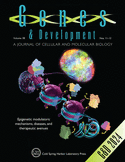ChAHP2 and ChAHP control diverse retrotransposons by complementary activities
- Josip Ahel1,5,
- Aparna Pandey1,5,
- Michaela Schwaiger1,2,5,
- Fabio Mohn1,
- Anja Basters1,4,
- Georg Kempf1,
- Aude Andriollo1,3,
- Lucas Kaaij1,
- Daniel Hess1 and
- Marc Bühler1,3
- 1Friedrich Miescher Institute for Biomedical Research, Basel 4056, Switzerland;
- 2Swiss Institute of Bioinformatics, Basel 4056, Switzerland;
- 3University of Basel, Basel 4003, Switzerland
- Corresponding author: marc.buehler{at}fmi.ch
-
↵5 These authors contributed equally to this work.
Abstract
Retrotransposon control in mammals is an intricate process that is effectuated by a broad network of chromatin regulatory pathways. We previously discovered ChAHP, a protein complex with repressive activity against short interspersed element (SINE) retrotransposons that is composed of the transcription factor ADNP, chromatin remodeler CHD4, and HP1 proteins. Here we identify ChAHP2, a protein complex homologous to ChAHP, in which ADNP is replaced by ADNP2. ChAHP2 is predominantly targeted to endogenous retroviruses (ERVs) and long interspersed elements (LINEs) via HP1β-mediated binding of H3K9 trimethylated histones. We further demonstrate that ChAHP also binds these elements in a manner mechanistically equivalent to that of ChAHP2 and distinct from DNA sequence-specific recruitment at SINEs. Genetic ablation of ADNP2 alleviates ERV and LINE1 repression, which is synthetically exacerbated by additional depletion of ADNP. Together, our results reveal that the ChAHP and ChAHP2 complexes function to control both nonautonomous and autonomous retrotransposons by complementary activities, further adding to the complexity of mammalian transposon control.
Keywords
Footnotes
-
Supplemental material is available for this article.
-
Article published online ahead of print. Article and publication date are online at http://www.genesdev.org/cgi/doi/10.1101/gad.351769.124.
-
Freely available online through the Genes & Development Open Access option.
- Received May 14, 2024.
- Accepted June 7, 2024.
This article, published in Genes & Development, is available under a Creative Commons License (Attribution 4.0 International), as described at http://creativecommons.org/licenses/by/4.0/.












